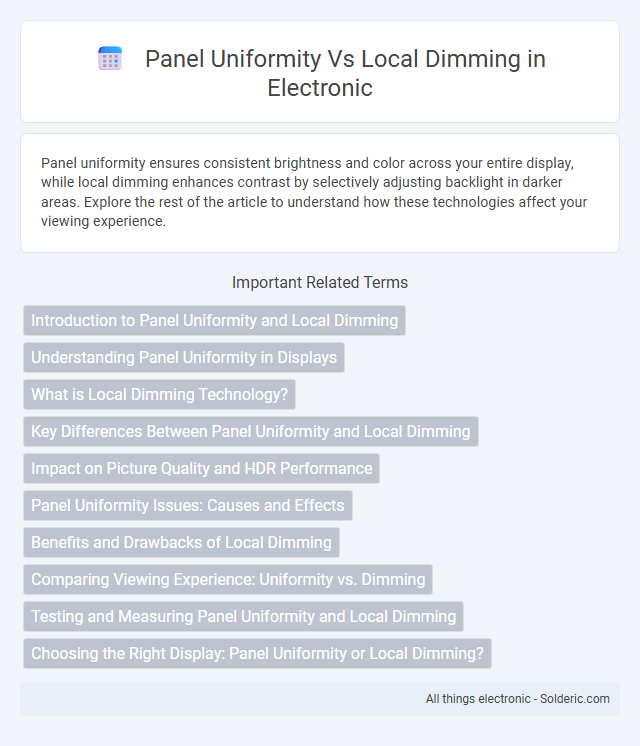Panel uniformity ensures consistent brightness and color across your entire display, while local dimming enhances contrast by selectively adjusting backlight in darker areas. Explore the rest of the article to understand how these technologies affect your viewing experience.
Comparison Table
| Feature | Panel Uniformity | Local Dimming |
|---|---|---|
| Description | Even brightness and color distribution across the screen. | Dynamic control of backlight zones to enhance contrast. |
| Purpose | Ensures consistent image quality without brightness or color variations. | Improves black levels and contrast ratio by dimming specific screen areas. |
| Benefits | Reduces clouding, flickering, and color tinting. | Enhances HDR performance and deepens black scenes. |
| Common Issues | Uneven brightness, color shifts, and dirty screen effect. | Halo effect and blooming around bright objects. |
| Technology Dependency | Affected by panel manufacturing quality and type (IPS, OLED). | Depends on local dimming zones and LED backlight design. |
| Impact on Viewing Experience | Provides consistent visual clarity and color accuracy. | Delivers enhanced contrast but may cause artifacts. |
Introduction to Panel Uniformity and Local Dimming
Panel uniformity ensures consistent brightness and color across your entire display, preventing patches of uneven shading and enhancing visual comfort. Local dimming technology improves contrast by selectively dimming backlight zones, resulting in deeper blacks and more vivid images. Understanding the balance between panel uniformity and local dimming helps optimize your viewing experience for clarity and dynamic range.
Understanding Panel Uniformity in Displays
Panel uniformity in displays ensures consistent brightness and color accuracy across the entire screen, minimizing visible inconsistencies like light spots or color shifts. Local dimming enhances contrast by selectively dimming backlight zones, but its effectiveness depends on the panel's base uniformity to prevent uneven lighting artifacts. Your viewing experience improves significantly when panel uniformity is optimized, offering deeper blacks and more vibrant visuals without distraction.
What is Local Dimming Technology?
Local dimming technology enhances panel uniformity by selectively dimming backlight zones to improve contrast and black levels. Unlike traditional uniform backlighting, it adjusts brightness in specific screen areas, reducing halo effects and improving detail in dark scenes. Your viewing experience benefits from deeper blacks and more vibrant colors, especially in HDR content.
Key Differences Between Panel Uniformity and Local Dimming
Panel uniformity refers to the consistent brightness and color reproduction across the entire display surface, ensuring an even visual experience without patches or color shifts. Local dimming enhances contrast by selectively dimming sections of the backlight to produce deeper blacks and improved dynamic range, primarily in LED and QLED displays. The key difference lies in panel uniformity affecting overall screen consistency, while local dimming targets contrast and black level precision within specific zones.
Impact on Picture Quality and HDR Performance
Panel uniformity ensures consistent brightness and color accuracy across the entire screen, crucial for delivering a balanced viewing experience without distracting patches. Local dimming technology enhances HDR performance by dynamically adjusting backlight zones, boosting contrast and deepening blacks for more vivid highlights and improved shadow detail. Combining superior panel uniformity with advanced local dimming results in richer image depth and enhanced clarity, optimizing overall picture quality in HDR content.
Panel Uniformity Issues: Causes and Effects
Panel uniformity issues in displays primarily arise from variations in backlight distribution, inconsistent pixel performance, and manufacturing defects, leading to noticeable brightness and color discrepancies across the screen. Local dimming technology attempts to improve contrast by selectively dimming backlight zones, but it can introduce halo effects and uneven brightness transitions that exacerbate uniformity problems. These inconsistencies reduce image quality, impair viewing experience, and can cause eye strain during prolonged use.
Benefits and Drawbacks of Local Dimming
Local dimming enhances panel uniformity by selectively adjusting backlight zones, improving contrast and deepening black levels for a more dynamic viewing experience. However, this technology can cause halos or blooming around bright objects on dark backgrounds and may lead to uneven lighting in certain scenes. Understanding the balance between improved contrast and potential artifacts helps you choose displays that best suit your viewing preferences.
Comparing Viewing Experience: Uniformity vs. Dimming
Panel uniformity ensures consistent brightness and color across the entire screen, providing a seamless viewing experience without distracting patches or variations. Local dimming enhances contrast by selectively darkening specific screen areas, improving black levels and detail in HDR content but can introduce halo effects or uneven lighting. The choice between uniformity and local dimming affects perceived image quality, with uniformity offering smooth visuals and local dimming delivering deeper contrast in suitable content.
Testing and Measuring Panel Uniformity and Local Dimming
Testing and measuring panel uniformity involves assessing luminance and color consistency across the entire display to ensure minimal deviations and avoid noticeable spots or patches. Local dimming evaluation focuses on the precision and effectiveness of dimming zones in enhancing contrast without causing halo effects or blooming artifacts. Your display's performance can be accurately analyzed using specialized equipment like colorimeters and spectroradiometers to quantify uniformity and dimming capabilities.
Choosing the Right Display: Panel Uniformity or Local Dimming?
Choosing between panel uniformity and local dimming depends on your primary viewing needs, as panel uniformity ensures consistent brightness and color across the entire screen, essential for tasks requiring color accuracy like photo editing. Local dimming enhances contrast by controlling backlight zones individually, producing deeper blacks and improved HDR performance, which benefits movie watching and gaming. Prioritize panel uniformity for professional visual work and local dimming for immersive entertainment experiences.
Panel Uniformity vs Local Dimming Infographic

 solderic.com
solderic.com